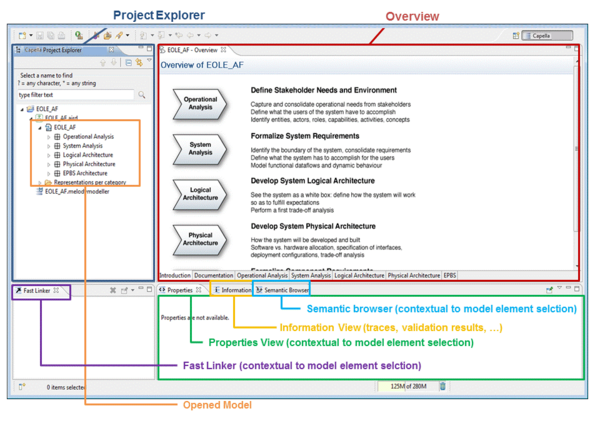Notice: This Wiki is now read only and edits are no longer possible. Please see: https://gitlab.eclipse.org/eclipsefdn/helpdesk/-/wikis/Wiki-shutdown-plan for the plan.
Capella/Features
< Capella
Features
Following figures highlights Capella key points. For a more detailed description, do not hesitate to visit the dedicated pages on the website for the features and the Arcadia method.
- First, Capella defines an engineering language, that has been specified by recognized engineering experts from Thales. The resulting intuitive engineering environment allows the engineers to concentrate on the definition of their systems and software architectures instead of having to determine how to use a complex general purpose modelling language such as UML or SysML to capture their information. It also shorten the learning curve of new engineers in a project ;
- As a tool, Capella automates engineering tasks ensuring productivity and quality, avoiding engineers to perform repetitive and cumbersome modelling tasks (e.g. automated maintenance of the model out of graphical editing in compliance with the unified engineering language business rules, automatically proposing pertinent information while editing information also based on the engineering rules, producing information out of model information such as function to component allocation matrices, checking additional engineering rules wherever and whenever needed, etc.). Model information consistency is systematically and automatically maintained during the editing process and can also be evaluated a posterior by advanced checking tools ;
- It is also designed to provide a framework ensuring a seamless engineering workflow. Tooling is provided and can be completed to manage information propagation and maintenance and to manage traceability at different stages of the engineering activities: internally between engineering levels, externally from upstream and to downstream engineering phases or with specialty engineering activities and environments. Transitions is ensured in an iterative and conservative way ;
- A Capella major innovation is to provide the built-in support to Viewpoints. Viewpoints, through language and tooling extensions, can be used for:
- Adding additional engineering preoccupations (e.g. Performance, Safety, Costs, etc.) to the engineering backbone for addressing speciality engineering ;
- Or specializing the engineering environment (i.e. for a Domain -e.g. ATM or Avionics-) for customisation.
- Multi-criteria analysis of the Systems and Software Architectures through a combination of Viewpoints allows effective early validation during the definition phase, i.e. before the implementation and the IVV phases, inducing significant re-engineering costs savings ;
- Finally, Capella is compatible with multi-user and configuration management services ;
- Capella provides engineering know-how and best practices capitalisation and reuse at all levels : by tooling an Arcardia process in the backbone engineering environment, but also by allowing the definition and usage of dedicated engineering viewpoints.

